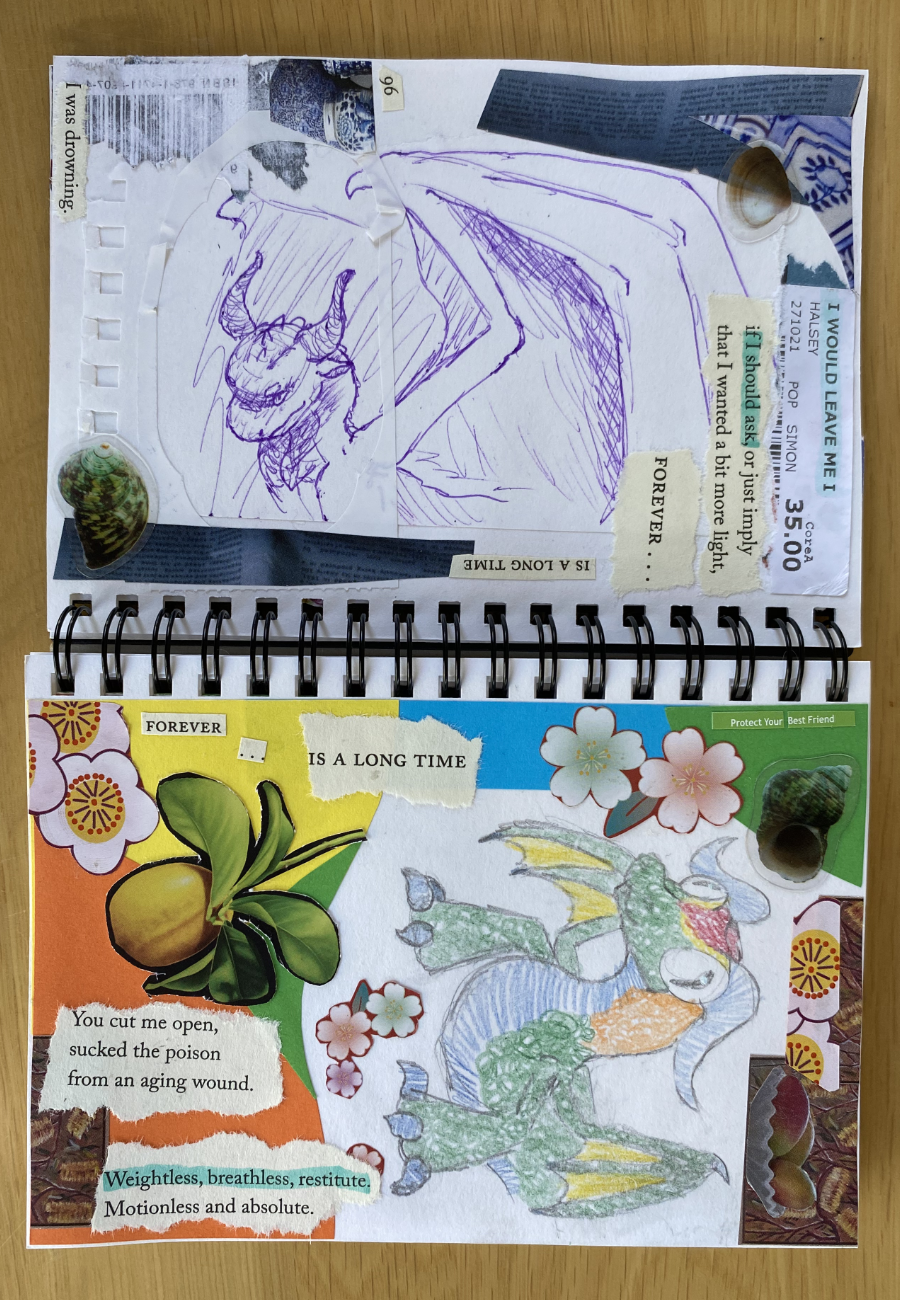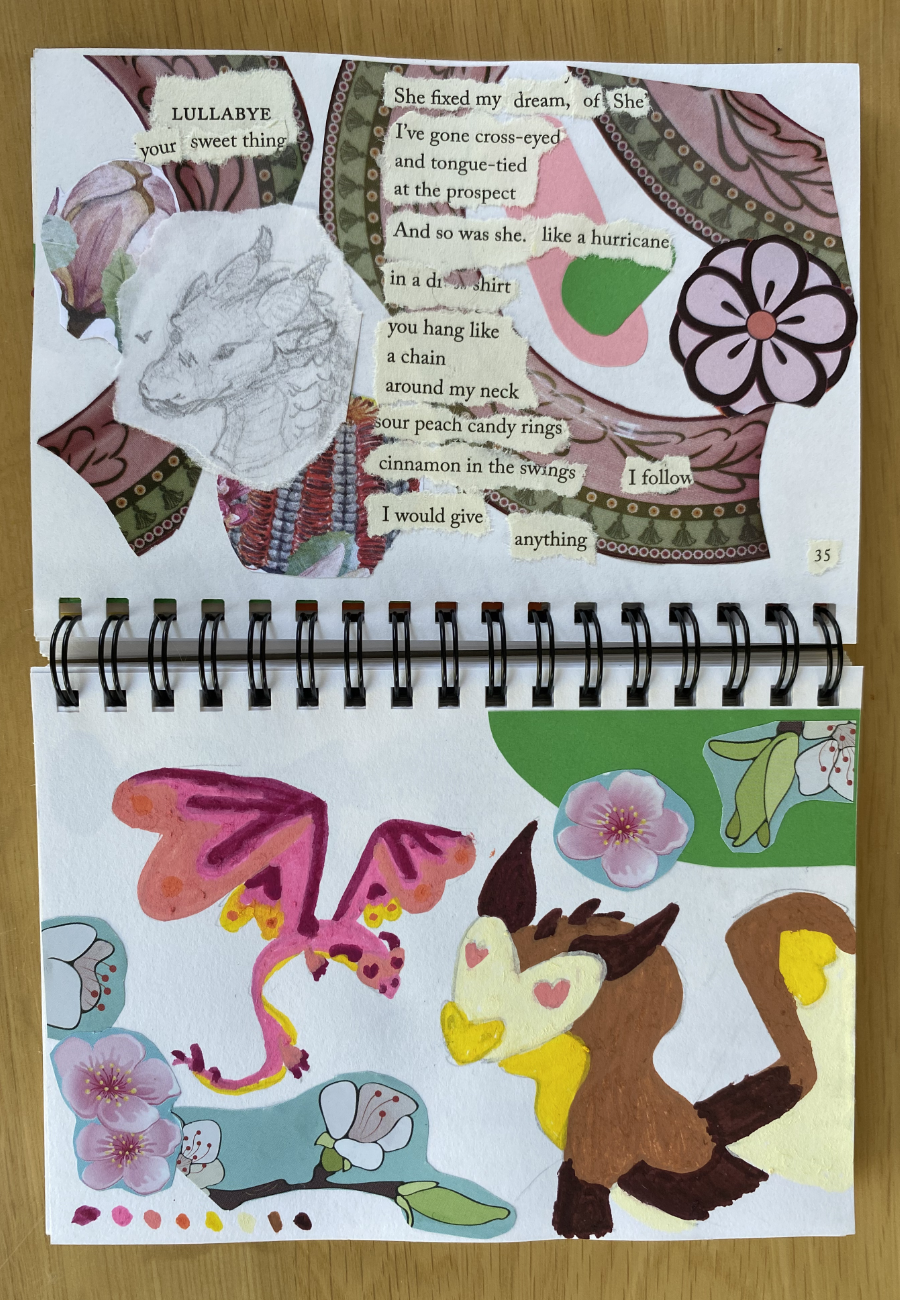My Art :)
This is a chronical of my current sketchbook, updated as I complete each 2-page spread. Most (not all) pages are focused on a certain species of dragon so I've included some facts about each one! :)

Page 1: Draconinae Ales 'Gliding Dragon'
The first page of this sketchbook, I wanted to include an introductory poem here to set the tone. D. Ales isn't my favourite dragon, but it is the dragon I find myself drawing the most often, so it felt fitting to break in a new sketchbook with this guy.
I didn't quite get the colours right since none of my markers are quite the right shade of grey for the belly, but this isn't a scientific diagram so it's ok.
Most of the extra stuff on this page is from some random brochure I've had laying around forever, I don't even remember what it's for- I liked the outfits all these guys were wearing, the colours are wonderful.

Page 2: Forever... is a long time (Misc Species)
This spread has a sketch I need in my maths book I really liked even though it isn't based on any specific dragon species. I don't think dragons have looked this menacing in centuries. I guess that's what domestication does.
I think it's fitting to pair it with the goofiest Draconinae Ales I've ever drawn, haha. It's also not super anatomically accurate... but I like how it looks anyway.
More poetry (there's some in every spread), I've been making these out of a book of poetry I got for... I got as a gift for someone who didn't want it. So now I'm making poetry from the poems, I think there's something poetic about that. Oh god, I've said poem way too many times it doesn't mean anything anymore D:


Page 3: Sketches (P. Andontus)
These are some doodles of my favourite dragon, P. Andontus aka the burrowing dragon! Most people presume these dragons live entirely underground like moles, but in fact they're more comparable to rabbits, to the point that burrowing dragons are known to take over rabbit warrens when they get the opportunity!
Weirdly, my dragon encyclopedia calls them a helmet dragon, but it does list burrowing dragon as an alternate name. Maybe I should be calling it a helmet dragon? Maybe that's more accurate to the Latin name, I'm not sure, I don't speak Latin- no one does, haha.
I think I'll keep calling it a burrowing dragon because that's what everyone calls them around here. Well, usually they call them 'a bloody nuisance' but that's just because they turn over the garden sometimes. I believe my resident P. Andontus is a juvenile female searching for a good place to make a nest. I've only caught glimpses of her in the garden, burrowing dragons are very shy- I think she likes our strawberry patch.


Page 4: Maaqwi Contusumae 'Banana-Fish Dragon'
This is one of my least favourite dragons I've drawn, but a pretty good drawing, and along with it is one of my favourite poems too. Not that I don't like the banana dragon, or any dragon really, but I really hate bananas, haha.
I think the evolutionary history of M. Contusumae is interesting, they're a lot like whales in that it evolved from a land-based species and returned to the water. But I've never heard if it has an extant land-based counterpart like hippos are to whales.
I also included some more doodles from my schoolwork, I think I'll be putting these in more often too. They aren't anatomical but I have fun drawing them so maybe that doesn't matter too much?

Page 5: Anguis Astilio
The legless lizard of dragons, A. Astilio is one of the few dragons who have entirely lost their wings. At this point they're only identifiable as dragons by their skull structure, especially the horns.
I love the range of colours in their scales, and I think they're one of the only dragons I've seen to have iridescent horns! I wonder if their diet effects the way they produce keratin? Or maybe they just don't have much wear and tear on them due to behavioural differences? I'll have to research this
Also, I always forget how much I love sunflowers, I need to plant some! I think I got some seeds for one of my birthdays but they might be a few years old now- can seeds go off? I wish I knew half as much about plants as I do dragons.

Page 6: Pygopodidae Laticauda 'Burrowing Dragon'
My favourite guy! The burrowing dragon :) The colours of their scales always remind me of tea and milk, I bet they feel just as smooth and warm! Though, dragons are cold-blooded, so maybe not nearly as warm.
I also included some more doodles, I really like these ones!
Fun fact: Did you know that P. Laticauda go much of their lives without wings? Many dragons rely heavily on their wings (some are even hexapedal!), but I think the most interesting ones are those who can live entirely without them! True to their name, burrowing dragons spend much of their early lives underground, safe from predators, and so have little need for added mobility. Wings are only developed when the dragons reach sexual maturity, and are far larger in females so they can search far and wide for the perfect place to dig their burrow.

Page 7: Vegaviidae Columbinaceus
A species with some of the most dramatic sexual dimorphism in all of the Senidraconyes class. When first discovered, taxonomists incorrectly assumed the males and females to be two separate species, but further study revealed that the two have near identical biological structures, despite their dramatic difference in size. The males are anywhere from half to just a quarter of the size of females, and have gaudy coloured scales while females are dull brown tones. As such they also tend to have drastically lower life spans, living just long enough to find a mate.
Due to this fact, V. Columbinaceus dragons technically bond for life, with males playing a vital role in protecting eggs while females hunt. However, a female will have many mates in her lifetime as her many male partners live out their natural life spans. While females have been observed displaying 'grieving' behaviours over the loss of their mates, going so far as to retain sticks, bottlecaps or other gifts gathered by that mate.
This may appear to undermine their relation with their next partner, however, this does not seem to be an issue. There are many reports documenting females with multiple simultaneous relationships which results in several males guarding her nest.
I've noticed some of the gliding dragons in my back yard carrying flowers, I wonder if they give their mates gifts like V. Columbinaceus do? My encyclopedia doesn't mention anything about their mating behaviours, maybe no one has published a study the behaviours of feral dragons yet?
